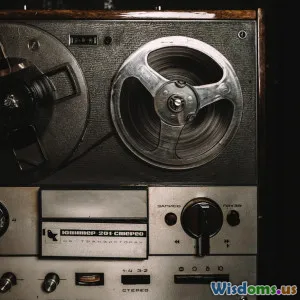
From Box Office Flops to Fan Favorites The Journey
13 min read Explore how box office flops became beloved fan favorites over time, transforming reputations in pop culture history. (0 Reviews)
From Box Office Flops to Fan Favorites: The Journey
A single night at the box office can change the destiny of a film—or so it seems. Yet, the real story of cinema unfolds over time, as audiences discover, rediscover, and often fall in love with films once prematurely dismissed. Box office bombs can take on new lives, transforming into beloved classics thanks to cult followings, critical reevaluations, and changing cultural tides. Let’s explore the remarkable journey from flop to fan-favorite.
The Anatomy of a Flop: More than Just Numbers

When discussing flops, most people think of underwhelming ticket sales, but that’s only the tip of the iceberg. Flops often result from myriad factors: mismarketing, poor release timing, or even being too avant-garde for contemporary tastes.
Case in point: Blade Runner (1982). Released to lukewarm reviews, Ridley Scott’s science-fiction noir grossed just $41 million globally against a reported $30 million budget—a modest performance for a film of its scale. Critics were divided, and multiplexes favored more accessible fare like E.T. the Extra-Terrestrial. At the box office, Blade Runner failed to fly.
But the numbers ignore nuance:
- Innovative visuals and ambitious concepts ahead of their time often alienate initial audiences.
- Films released against heavy competition (e.g., summer blockbusters) can be unjustly overshadowed.
- Poor marketing can misrepresent a film’s appeal or genre, confusing potential patrons.
What’s dismissed as a disaster can become groundwork for longevity—one that loyal fans may later recognize.
Cult Classics: How Disaster Breeds Devotion

One of Hollywood’s ironies is how some of the most cherished movies today were originally reviled. The cult classic emerges not from initial triumph but from the tenacity of enthusiasts who champion the underdog.
The Rocky Horror Picture Show (1975): Despite commercial failure at first, its midnight screenings became legendary. Fans would dress in costume, memorize the dialogue, and invent audience callbacks, crafting an experience that exceeded anything on screen. Its total lifetime gross, through re-releases and revivals, climbed far past its original shortfall.
Other cult transitions include:
- Donnie Darko (2001), which made only $7.5 million on a $4.5 million budget but gained status as a surreal favorite thanks to DVD sales and persistent grassroots buzz.
- Big Trouble in Little China (1986), which was lambasted on debut but is now celebrated for its genre-blending zaniness.
Cult followings thrive on:
- Fan events engaging community participation.
- Quote-worthy scripts or unique aesthetics.
- Themes resonating more with specialized audiences than the general public.
Foregoing mainstream acceptance, cult classics demonstrate how passionate subcultures can rescue forgotten films from oblivion.
Rediscovery Through Home Video and Streaming

The advent of VHS, DVD, and, later, digital streaming radically changed movie longevity. Films that failed their initial theatrical run gained new lives on home screens.
Blockbuster video rentals in the ’80s and ’90s gave second chances to countless films:
- The Shawshank Redemption (1994), now IMDb’s top-rated movie, underperformed at the box office initially but exploded in home video sales and cable airings.
- Office Space (1999) similarly flatlined at theaters but blossomed into a pop culture touchstone through relentless rewatching on disc and TV.
Streaming’s influence compounds this:
- Platforms like Netflix, Amazon Prime, and Disney+ have surfaced hidden gems, such as Hocus Pocus (1993), now a Halloween staple years after its flop status.
- Recommendation algorithms and curated lists make it easier than ever for audiences to stumble onto films overlooked upon release.
Fact: More than 30% of Netflix users have reported discovering a title they had never heard of—which sometimes includes past theatrical bombs now repositioned as cult essentials.
Reassessment: The Role of Critics and Changing Perspectives

While financial results are immediate, critical opinion evolves. Films labeled as “failures” early on are sometimes reassessed as the critical paradigm shifts.
A prime example: It’s a Wonderful Life (1946). Considered a box office disappointment, it ultimately soared into the pantheon of Christmas classics—thanks in part to public domain TV broadcasts and reconsideration of its heartfelt narrative.
Factors leading to critical reassessment:
- New generations of critics and scholars offering fresh perspectives.
- Social or technological contexts catching up to a film’s themes or innovations (e.g., the environmental warnings of The Thing (1982)).
- Retrospective festival screenings rekindling appreciation.
Sites like Rotten Tomatoes and Metacritic now track how critical averages change over time, reflecting the evolutionary nature of taste. Review aggregate statistics show some "rotten" films eventually shifting toward positive consensus as years pass.
Fandom Power: Memes, Social Media, and Grassroots Revival

The digital age ushered in game-changing ways fans can champion underloved films. Online communities, memes, and viral trends regularly resurrect flops as fan favorites.
Consider Scott Pilgrim vs. the World (2010): Dubbed a flop under its $47 million budget (it fell short at the box office), it experienced viral reappraisal through social media. Fan art, memes, and anniversary campaigns have kept the film prominent in online culture.
Other modern examples include:
- Jennifer’s Body (2009), ignored on release, but rejuvenated as a feminist cult film through meme-driven communities and TikTok appreciation.
- Speed Racer (2008), panned by critics, but rehabilitated via YouTube video essays and Twitter retrospectives highlighting its visual wizardry.
Memes extract moments from obscurity, making them social currency, while hashtags and fan campaigns foster participatory discovery. Platforms like Reddit’s /r/MovieSuggestions now spread word of mouth far beyond the local theater.
Merchandise, Spin-Offs, and Extended Legacies

Sometimes, a flop discovers its audience through collectibles and spin-offs. Merchandise—action figures, soundtracks, graphic novels—can reignite interest, transforming a commercial dud into an enduring brand.
One of the greatest turnarounds is: Firefly (2002), a TV science-fiction western: Despite being canceled after one season, DVD sales soared due to avid fans (“Browncoats”). Their passion led to books, comics, and ultimately, the box office redemption of the film Serenity (2005).
Similarly, Tron (1982) inspired video games and toys well after its disappointing gross, sparking enough nostalgia to birth Tron: Legacy (2010)—a belated sequel that benefited from cultivated fan support.
Merchandise does more than drive profit; it keeps stories alive. Fans collect and create, signaling ongoing relevance and bond to a film ill-served in its premiere.
Lessons for Filmmakers: How to Bounce Back from a Flop

Every director, producer, or screenwriter fears failure. Yet, the stories of films transitioning from bomb to beloved are as instructional as any textbook.
Strategies uncovered from these journeys include:
- Accepting that initial failure isn’t always due to quality; externalities (timeliness, trends, market competition) play a huge role.
- Cultivating niche communities rather than chasing broad appeal.
- Utilizing digital distribution for second (and third) chances.
- Interacting directly with your audience on platforms such as Twitter, Discord, or Substack.
Filmmakers like Edgar Wright (Scott Pilgrim vs. the World) and Mike Judge (Office Space) have seen their "failures" develop tenacious afterlives—a testament to the merits of unique voice and persistence.
Why Box Office Numbers Don’t Tell the Whole Story

Ultimately, box office metrics are no longer the definitive judges of a film's fate. Market analysis might declare a film dead on arrival, but history frequently overturns that verdict.
Surveys reveal that up to 40% of people have grown to appreciate and advocate for flops years after ignoring or criticizing them. Historical records are filled with examples—from The Thing and Heathers to Fight Club and Children of Men—where audiences rewrite a film’s legacy over decades.
The evolving tale of flops-turned-fan-favorites proves movies are living works—a fusion of creator intention, consumer reaction, and temporal context.
When a film falters at the box office, it’s easy to write it off as a failure. Yet, as countless classics show, true legacy emerges over time—through the passion of devoted fans, the magic of discovery, and the ongoing, unpredictable pulse of pop culture. As the curtain falls on one generation, it often rises for the next, proving that flops may simply be fan favorites waiting to happen.
Rate the Post
User Reviews
Popular Posts


















